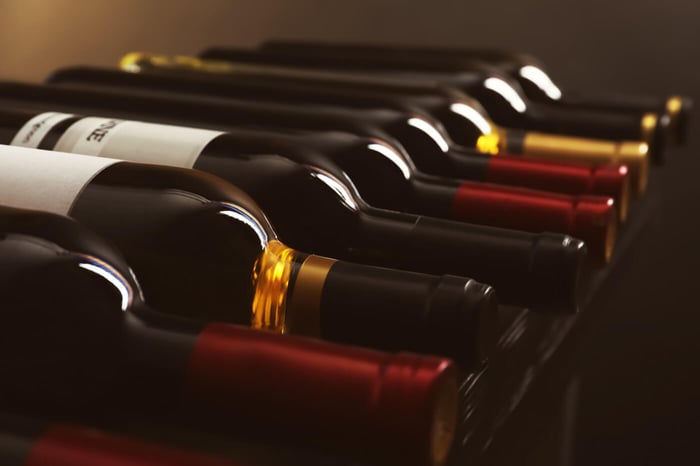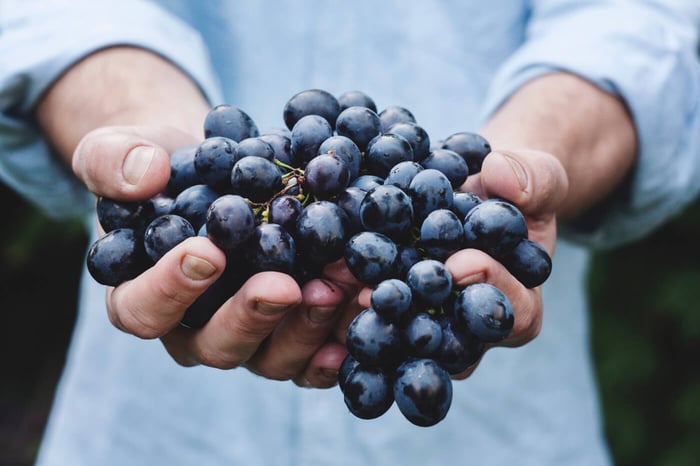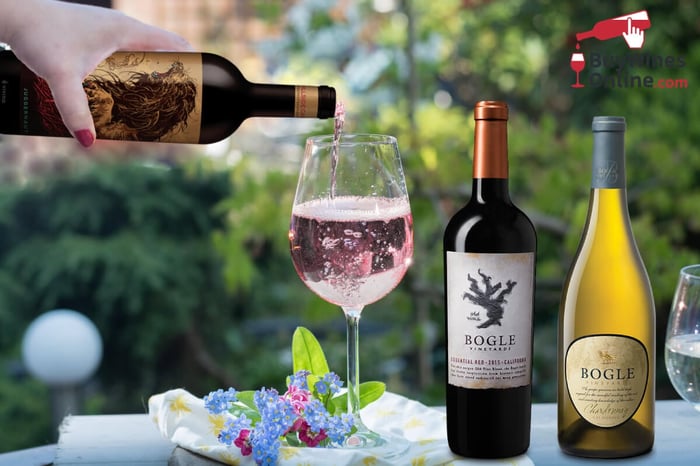Wine Basics for Beginners - Wine Guide
When approaching wine, it can seem like there are tons of different styles and distinctions and flavors that can make it hard to learn more about it without 'proper training'. Here's where we come in; wine isn't just some high-class drink for the froo froo anymore. Today I am going to be going over several different wine-centric topics: How wine is made, different types of wine, popular wine pairings, terms, and a handy dandy price guide. Anyone can become an Oenophile (wine lover) with a little practice, so check out some of our tips in our beginner’s guide to wine.
How Wine is Made
Wine is made from fermenting wine grapes! Vineyards will collect their red and white grapes in bins and tubs where they are then moved to the crushing pad where they are destemmed and lightly crushed.

Wine grapes crushed by hand in a small winery.
Over time, the juice is pressed and released from the grapes, which allows the sugar and yeast to react and ferment, eventually turning into wine. Depending on the wine, it can continue aging in barrels (sometime oak) to continually enhance the flavor.
Different Types of Wine
Even though all wine goes through a similar process during creation, there are many wines that vary in smell, taste, flavor profile, etc. The different types of wine can be broken down into four main classifications: Red wine, White wine, Rose wine, and Sparkling wine. There are also regional wines and other unique categorizations like Dessert wine, but these are less common than the main designations.
To assist you in your wine 101 journey, I've created a list below of some of the most common wine varietals along with common taste profiles:
Types of Red Wine
Cabernet Sauvignon: Dry, with tannins and dark fruit, full-bodied flavors, blackberry and spice
Pinot Noir: Red fruit dominant wine, light to medium bodied with dry cherries and soft tannins, light acid
Zinfandel: Dry and fruit forward, full of dark fruits like plums, and dark chocolate aromas
Merlot: Soft and silky with raspberry and plum flavors, dry and earthy notes
Red Blend: Depending on blend, can range from off-dry to dry, Bordeaux blends are dry and deep flavored with full bodied dark fruit flavors
Malbec: Flavors of plum and blackberry with gritty earthy tannins and a flavor profile full of fruit
Types of White Wine
Chardonnay: Dry flavors of tropical fruit and apples, oaky with notes of coconut and and creamy texture and medium body
White Blend: Dry white wine that can vary based on the blend.
Riesling: Can have a body that is light-bodied or medium-bodied, light fruity flavors and earthy green apple and pear ranging from sweet to off dry
Moscato: Sweet (This is great wine for beginners), light bodied and a juicy fruit flavor with peaches, pears, crisp apples
Pinot Grigio: Semi-sweet off dry, citrus fruit aromas, pears, honeysuckle, light to medium bodied
Sauvignon Blanc: Dry wine with a light to medium body and a good bit of acid, citrusy flavors and a creamy finish
Other Wine Styles
Rose: Rose wines are made from black and red grapes, but they are only left to soak in the grape juice for a limited period of time. This results in a lighter color than red wine -- and the flavors of a rose can vary from dry to sweet.
Champagne & Sparkling Wine: Sparkling wine is carbonated as a result of the carbon dioxide that gets trapped in the wine during the fermentation process; this results in bubbles in the wine.
Popular Wine Pairings
Adding wine as an ingredient for meal preparation is a great way to boost the flavors of food -- allowing increased intensity and flavor depth from both the wine and the food. Typically, you're going to have the best luck by choosing a wine that you already enjoy; that way, you'll be able to pick up some of the subtle notes and flavors that the wine imparts into the food. Once you are able to identify food and wine that taste well together, you can get Wine Tasting. Here are a few general tips to aid in cooking with wine.
Red Wine Pairings
Red wines are best paired with bold flavored meats. One of the most classic combinations is a ribeye steak with a glass of cabernet sauvignon. The bitter tannins of the wine and the fattiness of the steak balance each other out perfectly.
White Wine Pairings
White wines are best paired with light meats like chicken or fish. Historically, citrus flavors like lemon have been used to brighten the flavors of certain seafood dishes. Adding Chardonnay or Pinot Grigio while cooking a salmon filet can result in some of the citrus notes in the wine imparting themselves into the food.
Check out some of our favorite tips for cooking with wine in our 'Cooking with Wine' blog.
Popular Wine Terms
Dry: Dry is the opposite of sweet, brut. A Bordeaux blend is a typically dry red wine
Off Dry/Semi-Sweet: Midway point between dry and sweet. Typically, balanced and smooth profiles
Sweet: Sweet is the opposite of dry. Moscato wine would be example of a sweet wine
Body: The feeling of the wine on your palate from the mix of alcohol and sugars -- can range from light-bodied to full-bodied
Tannins: Tannins are natural compounds found in foods that create the lip curling bitter flavor in the mouth. Red wines will typically have more tannins than whites.
Oak: When a wine ages in oak, the flavors of the wood are slowly imparted into the wine.
Bitter: Bitter is one of the most common notes in a tannic wine. The more tannins in the wine, the more bitter the wine will typically be.
Smooth: Smooth wine has tannins that have softened over time to create a wine that is not overly tannic.
Wine Price Guide
Though wine is traditionally thought of as a luxury item, increasing access through ecommerce solutions have begun to modernize an industry once thought stuck in the past. Brands like Caymus, Bogle, and Orin Swift continue to release wines at fair price points.
Here are some brands below that fall between certain price points! Check them out for the best wine deals on the internet:
Under $10: Barefoot, Pepperwood Grove Winery, SUTTER HOME, Yellow Tail, Woodbridge, Bogle Wine, Apothic, CHARLES SMITH WINES, 19 Crimes, Yalumba Family Winemakers, Flybird, Cupcake Vineyards
Under $25: Oyster Bay, Girl and Dragon, ChocoVine, Stella Rosa, The Dreaming Tree, Bread & Butter, Mionetto, Imagery Estate Winery, Hahn, Sebastiani, Justin Winery, Hope Family Wines, Benziger Family Winery, Z. Alexander Brown, CANTINA ZACCAGNINI, Caymus Vineyards, Miraval, Chateau d'Esclans, La Marca, Wade Cellars, Allegrini, Hess Collection, Josh Cellars
Under $50: The Prisoner Wine Company, Cloudy Bay Vineyards, Frog's Leap, Duckhorn Vineyards, ROBERT MONDAVI, LEVIATHAN, Cakebread Cellars, FRANK FAMILY VINEYARDS, FLOWERS, Charles Krug, ROMBAUER VINEYARDS, HONIG
Under $100: Merry Edwards, TOMMASI, Far Niente, Mayacamas, CHATEAU MONTELENA, JOSEPH PHELPS, Veuve Clicquot, JUSTIN, Stags' Leap Winery, Darioush Winery, PAHLMEYER, SILVER OAK, Laurent-Perrier, Nickel & Nickel
Under $250: OPUS ONE, QUINTESSA, Quilceda Creek, ORNELLAIA, Staglin Vineyard Estate, Diamond Creek, Dominus Estate
I hope that you enjoyed this basic wine guide. Figuring out the basics of wine 101 will help you to develop your observational skills as well as your critical thinking and tasting skills. What may seem intimidating at first might turn into a new favorite hobby, so grab a glass and start practicing.





